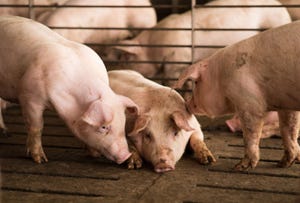Food security is sustainability
Pork producers keep tabs on EPA effluent limitation guidelines, highlight environmental stewardship efforts across the industry.

While environmental regulations and industry sustainability efforts are not at the forefront of the National Pork Producers Council’s Spring 2024 Legislative Action Conference this week, U.S. pork producers are continuing to monitor the Environmental Protection Agency’s recent proposed effluent limitation guidelines.
EPA’s proposed rule, “Clean Water Act Effluent Limitations Guidelines and Standards for the Meat and Poultry Products Point Source Category,” would revise the ELGs for wastewater discharged by meat and poultry processing and rendering facilities. EPA is considering a range of options in the current rulemaking, including more stringent effluent limitations on total nitrogen, new effluent limitations on total phosphorus, updated effluent limitations for other pollutants, new pretreatment standards for indirect dischargers, and revised production thresholds for some of the subcategories in the existing rule.
The estimated cost of EPA’s preferred option to reduce pollutant discharges by approximately 100 million pounds per year would be $232 million annually.
Duane Stateler, NPPC president-elect and a producer from Ohio, says the EPA has been “playing a hide the ball on rushing to complete the rules, putting a rural farm economy at risk.”
“They denied a request for additional time. They released a massive trove of additional documents the day before comments were due. The preferred option that EPA has given out to us, it looks at about $1 billion of annual compliance costs and approximately 74 packers and processors will go out of business,” Stateler says. “All that will mean is it will likely affect the smaller and more rural sized facilities that we have, and it will have a catastrophic impact on farmers. In today's environment that we live in, it's always the smallest that seem to take the blunt of the harm of any new regulations that come along because it's harder for them to financially go into everything it takes to compete with those compliances.”
Lori Stevermer, NPPC president and a pork producer from Minnesota, says these visits to Capitol Hill each year are a great time to talk about the environmental farm stewardship efforts already underway.
“I mean, when you look at our contribution to greenhouse gases, the pork industry is 0.4%, so less than 1%. Agriculture itself is less than 10%,” Stevermer says. “We’re doing a good job, and I think sometimes we don't say that enough. We let other companies talk about what they're doing and we forget that we are sustainable both in our practices and in our generational businesses.”
Stevermer offers up the Pork Cares Farm Impact Reports as an example, with several pork producers having a third party verify their production practices to show that they are indeed reducing their carbon footprint, as an industry by 8%.
“I think No. 1, for those of us that are using those reports to make sure we're sharing that information and then encourage the rest of the industry to undertake those Pork Cares Reports, because it really is powerful information and something that we need to remind our legislators that we don't need more regulations,” Stevermer says.
After all, these environmental stewardship efforts have been passed down from generation to generation, Stateler says.
“I was taught by my grandfather that they're not making any more ground, so we have to preserve what it is that we're farming today. And we have done that, from water quality to air quality, to soil conservation, wildlife habitat, producers care about sustainability and leaving behind a legacy for our next generations,” Stateler says.
“I like the fact that we sort of have the complete circle. On our farm, we don't rely on commercial fertilizers. We take the manure that we have produced from our buildings, and we apply that to the land in a way that protects the water quality and the soil health, and we use that to produce grain that we feed the hogs that we're able to give good protein to everyone across the United States.”
Rob Brenneman, NPPC vice president and a pork producer from Iowa, echoes Stateler’s sentiment, noting food security is truly sustainability.
“With supply of good quality protein that's balanced for every individual in the United States and on the planet, and the reports that we do on sustainability that is food security sustainability,” Brenneman says. “And every day we get up, that's what we shoot for, to be better and be more efficient and do more with less.”
About the Author(s)
You May Also Like





